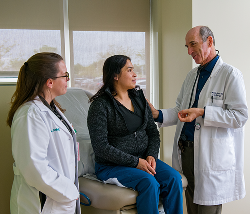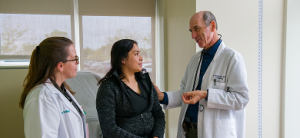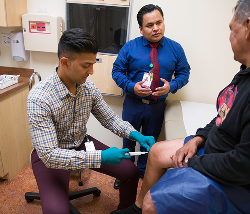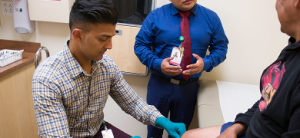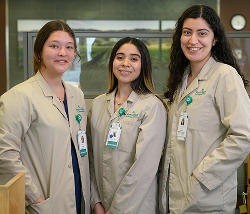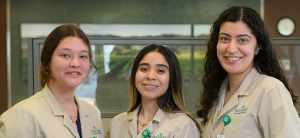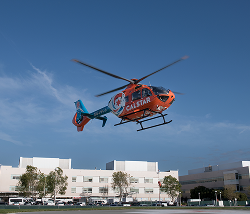Natividad’s Trauma Center turns 1
- January 6, 2016
By Roberto M. Robledo, The Salinas Californian
Dr. Craig Walls, emergency medical director at Natividad Medical Center, describes some of the new equipment at the hospital’s new Trauma Center at the facility unveiling in January 2015.(Photo: Jay Dunn/The Salinas Californian)
SALINAS, CA – January 6, 2016 – Last spring, firefighters found Derek Van Patter, 43, of Santa Barbara, unconscious off Highway 1 in Big Sur. He had been in a motorcycle accident.
In April, John Walker of Aptos was bicycling with friends when he lost control of his bike, crashed and became paralyzed.
In both cases, each man was flown to the Level II Trauma Center at Natividad Medical Center in Salinas.
Walker was unable to move his arms or legs at the scene and at Natividad required surgery as a result of a cervical spine fracture and spinal cord injury.
Van Patter’s injuries kept him hospitalized at Natividad for eight weeks.
Both of them thank the Trauma Center for saving their lives.
The center is celebrating its first anniversary this week.
Van Patter and Walker are two of the 1,300 medical emergency cases treated at the Trauma Center in the past year.
Their accidents also represent the vast majority of trauma cases – vehicle accidents and falls – handled at Natividad.
While public perception may suggest that gun violence in Salinas is responsible for most of the trauma locally, it represents only a small fraction of cases arriving at the Trauma Center.
“It’s less than 10 percent. The majority of cases coming in are … motor vehicle accidents and falls,” said Dr. Jim Hlavacek, Natividad’s chief of staff.
The Salinas-based Trauma Center is the only facility of its kind between San Jose and San Luis Obispo. It received final designation as a Level II trauma center in January 2015, after review by a team of trauma care experts and a 2-1/2-year campaign by Natividad, which was part of a four-year county process to designate a local hospital as a trauma center.
A trauma center comprises specialized surgeons, staff and equipment to treat the most severe and critical injuries.Trauma centers lower the risk of death in those cases by 25 percent.
Since its launch, the center also has attracted cases from outside Monterey County in communities that also have gone without such services for decades.
In the past year, “The volume of cases has been a little more than expected, primarily because of cases coming from Santa Cruz County, said Dr. Gary Gray, Natividad’s chief executive officer.
The center also has added or expanded some capabilities in the past year, said Dr. Alex Di Stante, Natividad’s chief of trauma and general surgery.
“We now have neurosurgery. … and intervention radiology which the hospital did not previously have,” he said.
Response time is impressive, they say. Trauma team members are required to arrive on scene within 15 minutes. They are there consistently before the patient even gets to the hospital, Di Stante said.
The center also has added new personnel, too — more doctors, nurses, nurse assistants and ancillary staff.
Almost all trauma patients have some form of insurance; the no-pay rate is around 35 percent, according to Hlavacek.
“The trauma center pays for itself,” he said.
Areas improvements are planned.
“The focus of next year will be in maturing the program and I think it’s matured quite well,” said Gray. “What we are thinking about now are capacity issues, optimizing patient flow through our systems, We had 1,300 patients this year; we could have 1,700 next year so we need to continue to think about how our program will mature and grow.”
Improvement plans include some remodeling to expand services such as diagnostic imaging, the rehabilitation unit, a new radiology lab, and installing a new MRI, two more CAT scans,
The center has not encountered any overcapcity issue. It has managed its patient flow and has not had to turn anyone away, Gray said.
However, Natividad continues to send some trauma patients out of the county after they’ve been stabilized, particularly pediatric cases under age 15.
Gray said “even though violence is a small portion of the injuries we receive, it’s been a major focus of our trauma prevention program, and intervention program CHOICES.
“If you were to ask most of us who live in Salinas what you consider to be the No. 1 issue, most of us would probably say violent crime and gangs, right?
“Violence is a public health issue. We’re taking it on from a prevention standpoint,” Gray said.
Di Stante indicated that what he is proud to see is the establishment of a trauma center in a county that previously went without this critical health care service. Salinas-area trauma patients were routinely flown to San Jose or San Francisco for treatment.
Added Hlavacek: "The emotional and financial impact of keeping injured patients in Monterey County is enormous. No longer are patients transported out of the county. The families can now stay here with their loved one instead of traveling to trauma centers miles away. Treating patients here means their medical dollars stay in Monterey County. This enables the hospital to hire more staff and expand services to the benefit of all."


